|
29th July 2020
A dating game: This is the second in a series of four blogs about the use of the set of photographs of LEO I that will ultimately enable us to rebuild a virtual LEO.
A dating game
Convinced that I had identified a set of photographs taken in the ‘calculator room’ at Cadby Hall, the next task was to begin to order the photographs together as a timeline. What were the photographs showing me that illustrated the passage of time and the life story of the LEO I computer?
It would be unfair to suggest that all the photographs came to our attention without a caption that included a date. However, I realised that these captions themselves were written at times different from that when the photograph was taken. Those of us old enough to know will remember that once upon a time a photograph first existed on a roll of film and when you finished the film, you would then take it to be developed. For us mere mortals that was often a local chemist and you got the prints back perhaps days or even weeks later. Captions on the back of photos were usually written a period after the photograph was taken, sometimes weeks and maybe years after it was taken and often by someone else. The message here is clear; beware the photograph’s caption - they may not be quite as accurate as you assume.

It was clear from the photographs themselves that there were a number of ‘types’. Many had been taken professionally. Well framed, clear, well lit, posed, etc; taken perhaps as part of a publicity event, marketing, a newspaper report, or magazine article. Copies of these photographs had been left with Lyons and their employees, some had found their way into collections that had been sold on several times and then into internationally famous collections such as Getty Images. Some were taken by the less skilled photographer and were perhaps motivated by an employee wishing to have a record of part of what was their workplace and colleagues. A few were a genuine record of the change that characterised the life of LEO. I am sure there were many more taken that are now lost and perhaps, fingers crossed, some are still out there waiting to be discovered.
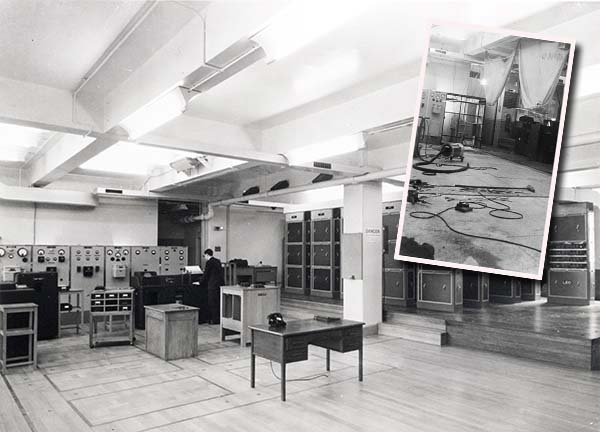
Photographers would often choose this end of the room to take their photograph. They could capture LEO and the main peripheral area (photo 3). It presented a problem; what did this end of the room look like? The insert photograph (photo 77) was simply a record of work that went on when the floor on the peripheral side was raised.
The 98 photographs I have currently identified are not all originals of course. You often find a copy of an original photograph and sometimes copies of copies. The digital world shows that the copies now permeate the Web. It is difficult to ascertain just where any photograph ‘began’. Some, therefore, are in bad shape, faded and scratched and no other clues as to their content other than the image itself.
A story in three acts
It became apparent that these photographs showed a life story in three parts.
Some were a record of those early days - I call that period the ‘construction’ phase. The ‘calculator room’ at Cadby Hall was once the administration offices for the Lyons Ice Cream Department. After the company had secured planning permission, the room was adapted for use to host a computer. This was more to do with moving a few walls, providing the necessary power supply, etc, certainly not any licks of paint!
If you use the LEO I PhotoApp here:
http://www.computinghistory.org.uk/leodev/photos/
You can scroll down and filter the photographs into one or more of the three phases. In those early days, you are as likely to see a saw hanging around as a soldering iron. It really was a workshop and not necessarily a fully planned out project. The first of the LEO racks would rise from the floor, a floor that had not yet been raised by 18 inches. A fact that had raised a question for some time; were the LEO racks placed on top of the raised floor or was the raised floor built around the racks? The photographs revealed the answer was the latter, to my surprise.
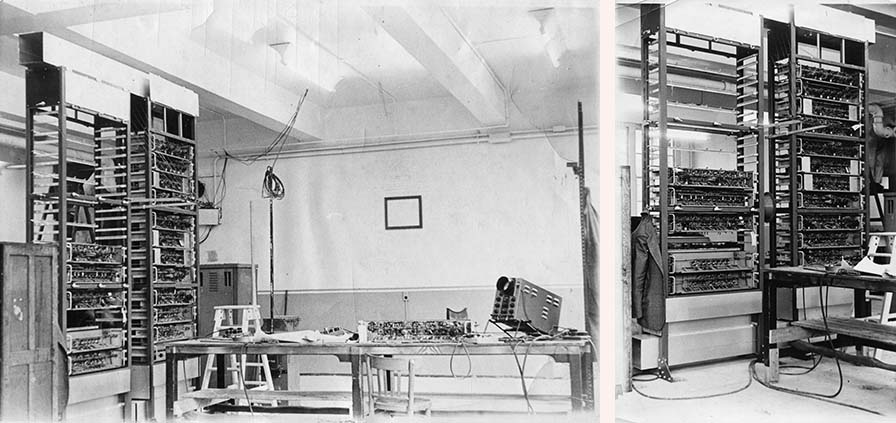
The photograph to the left (photo 20) clearly shows a curious construction area that includes the technical; an oscilloscope, plus a stepladder, old door and a coat. Notice the thin stripe on the wall - one of the telltale signs of that construction phase. On the right, (photo 21) taken at the same time, you can see a critical piece of evidence, the racks sitting on the real floor with triangular pieces of metal used to fix them to the floor and the ventilation ducts that would provide cool air to be drawn up through the valves.
Apart from the absence of much ‘LEO’ the photographs for the construction phase gave themselves away by showing that the decor in the background was still in ‘ice cream’ mode. Look for the thin stripe running around the room. That always told me that this was 1949 - March 1950, the very earliest evidence of the construction of LEO I and the room it was to call home.
As LEO came together they enter a period that is characterised better as a time of ‘development’. The room changed from one of basic construction to one more like a laboratory than a workshop. Attention was focused on making LEO work, work consistently, work correctly and begin to show its potential as a resource for Lyons. This period of time, March 1950 - 1953 covers the time in which the LEO team will abandon a key part of their initial planning, the use of magnetic tape to buffer input and output to LEO. By the end of this time, they have set themselves a new direction and one that will take them into the use of punched cards and punched tape as the means by which the company will communicate with the giant machine in the corner of the calculator room.
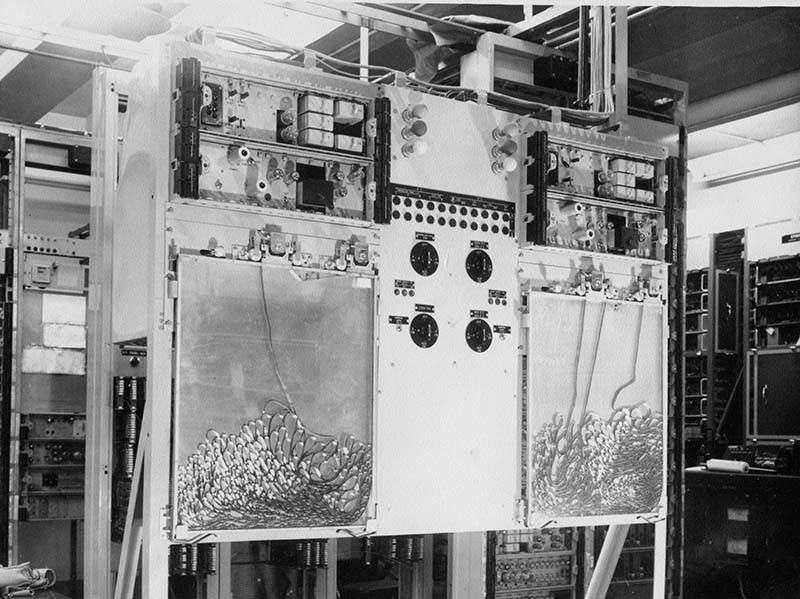
Photograph 47 shows the huge magnetic tape drive, not using reels but containing the tape inside a box. All of the equipment on the peripheral side of the room was, in the end, abandoned and replaced with punched card devices.
Finally, after the machine is built and after all the development has been completed two key themes will emerge. Firstly, there is a time when you have to stop ‘fiddling’ and start showing that this very expensive resource can become ‘operational’, perform well and begin to reward you for all that effort. From December 1953 LEO has to earn its keep. Secondly, the desire to innovate, improve, develop will not leave the team however, because by the time LEO I becomes fully operational, LEO 2 is being constructed and developed elsewhere and the story will continue.
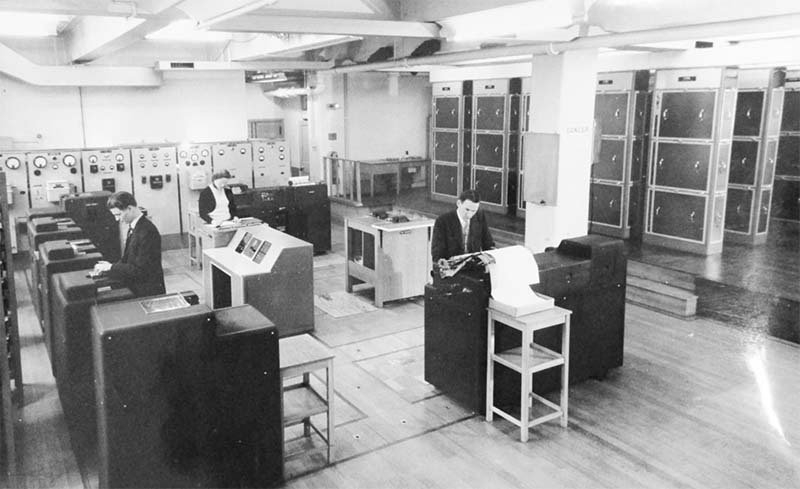
Photograph 92 showing the operational phase of LEO. The peripherals have been installed onto a false floor and LEO is ready to play its part in the Lyons business practices.
Photograph 81 shows that sad but proud moment for the Lyons team as LEO I has run its last program and punched its final card. In 1965 and after 13 years of work, it will be shut down and the new machines of LEO 2 and 3 and others from companies around the world will now take the limelight. LEO I will be dismantled and by 1983 even the great building Cadby Hall, will be demolished and all evidence of this key piece of computing heritage will be gone.
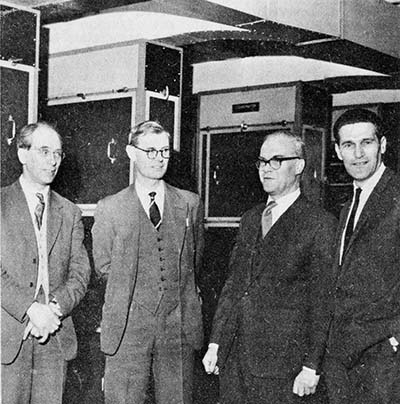
The photographs of the LEO I computer in the calculator room at Cadby Hall, show a place of change, of ideas, of experiment, failure and hard work. LEO I was the means by which a team of people worked through an idea and once they had, they moved on. LEO I had served its primary purpose and has a place now in the history of this technology and in particular the way the computer can be integrated to serve business needs, a fact today that is so very obvious.
Posted by: Chris Monk
|






